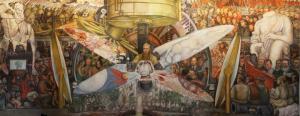Diego Velázquez: biography, paintings and characteristics of the master of the Spanish Baroque
Diego Velázquez is considered the most important painter of the Spanish Baroque period. His service as Philip IV's chamber painter allowed him to study the great masters of national art and international and, with it, he achieved a very personal style that would leave an indelible mark on the history of the painting.
But how was the life of Diego Velázquez? What are the characteristics of his style and his technique? What teachers had an influence on him? What were his most important works?
Biography of Diego Velázquez

Diego Rodríguez de Silva y Velázquez, better known as Diego Velázquez, was born in Seville in 1599. Of Portuguese grandparents, he was the son of Juan Rodríguez de Silva, and of the Sevillian Jerónima Velázquez.
Diego Velázquez's artistic training took place mainly in his hometown, Seville. There he received classes from two important teachers. Apparently the first was Francisco de Herrera. Later, he entered the workshop of the teacher Francisco Pacheco, who was a fundamental figure in his life and subsequent performance.
In fact, in 1618 he married the daughter of his teacher, Juana Pacheco, when he was not yet 19 years old. With her he had two daughters, Francisca and Ignacia, also born in the city of Seville.
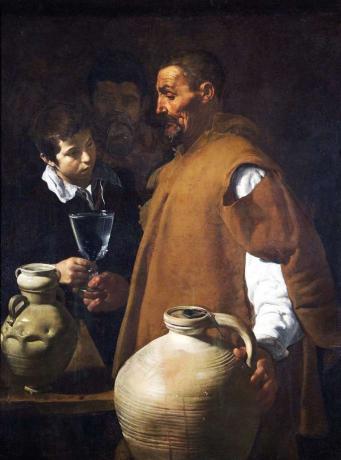
During his Sevillian period, Diego Velázquez extensively developed still lifes, as well as tavern scenes or kitchen scenes and religious paintings. In everything, Velázquez displayed a dark naturalism of great invoice that earned him wide recognition.
Of this stage, in fact, is his celebrated canvas print The water carrier of Seville, which gave him an important professional projection. This naturalism of Velázquez was in dialogue with the great masters Caravaggio and Ribera, representatives of this trend in painting that reached levels never before explored.
From Seville to the court of King Philip IV

Encouraged by his teacher and father-in-law, Velázquez traveled to Madrid in 1622 with the idea of obtaining a position in the service of the Spanish monarchy. Although he does not achieve his goal and returns to Seville, at that time he paints a portrait of Luis de Góngora that captures the attention of the capital's elite.
A year later, in 1623, he is called to Madrid by the Count Duke of Olivares to draw up a portrait of King Felipe IV. He liked it so much that he got the position of court chambermaster. Once installed, he was able to study the masters of the palace's collection, such as Titian, whom Velázquez considered his favorite painter.
Under royal protection, Velázquez produced much of his work. Given the conditions at the time, his production was mostly limited to portraits of the royal family, courtly portraits, and prominent personalities.
Velázquez had the recognition of important his peers in the world of European painting. This was the case of Pedro Pablo Rubens, who was in Madrid during those years and with whom he came to collaborate. It was Rubens himself who recommended that he travel to Italy to study the great masters. Under his influence, Velázquez produced the famous canvas The triumph of BacchusBut unlike conventional painters, his frank naturalism brought him closer to a still-life scene than to a mythological scene.
Travels to Italy in the work of Velázquez

In 1626, Velázquez traveled to Italy to study the great masters and perfect his artistic technique. During this period, he consistently studies the work of Tintoretto, Michelangelo Buonarroti, and Rafael Sanzio. Sheltered by such studies, he perfects his perspective model.
Velázquez returned to Madrid in the year 1631. His work, now mature and undergoing a perceptible change in style, was extremely prolific thereafter, and he collaborated with many royal projects, among which we can mention the decoration of the new Buen Retiro Palace and the Torre de la Stop. It is also the time of his large canvases The Surrender of Breda and the Coronation of the Virgin.
In 1649, Velázquez would travel a second and last time to Italy with the purpose of acquiring new pieces for the royal collection, both pictorial and sculptural. The trip was also an opportunity to deepen his studies.
In that period, Velázquez has a son out of wedlock, named Antonio. He also frees his slave Juan de Pareja, portrayed by him in one of his best-known works.
Influenced by the technique, composition and sensualism of the great Italian masters, the artist made his only female nude in Rome: Venus in the mirror. The prestige of the painter was such that, at his insistence, he managed to get Pope Innocent X to grant him a portrait. In this portrait, Velázquez would show off a new artistic line refined in Italy, which would guarantee his definitive consecration back to Spain.
As can be seen, Velázquez gained in technique and broadened the spectrum of subjects and pictorial genres that he executed. with equal mastery: still lifes, portraits, history paintings, genre scenes, religious scenes and scenes mythological. The rise in his prestige was unstoppable.
The definitive consecration of Velázquez and his last years
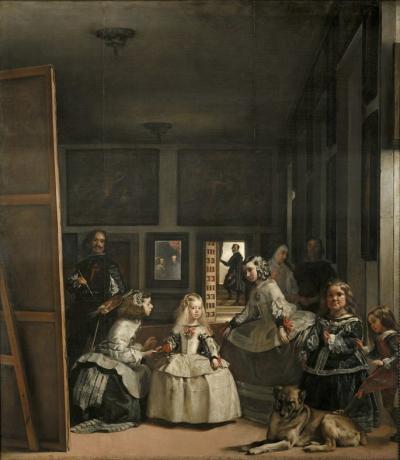
Upon returning to Madrid, Velázquez brought a supply of 300 new pieces for the collection of the royal house. After this, he was appointed lodger of the palace and continued to work for the king until the end of his days. At this stage, Velázquez obtained the long-awaited appointment as a knight of the Order of Santiago.
This will be the period when he paints his most famous work, Las Meninas, which reveals the artist's conceptual interest in dignifying painting alongside the liberal arts, while revealing the monarchy's concerns for royal succession.
Diego Velázquez died on August 6, 1660 with all the honors that a talented and consecrated artist like him could receive.
It may interest you:
- Picture Las Meninas by Diego Velázquez: analysis and meaning.
- Baroque: characteristics, representatives and works.
Characteristics, style and contributions of Diego Velázquez

Although Velázquez demonstrated great mastery in all of his stages, the transformation of his line to over the years, thanks to which he managed to develop a particular and distinctive language that would immortalize. Therefore, to talk about its style characteristics it is necessary to take into account its evolution over time.
In any case, as general features we can mention the following: spatial depth, use of the aerial perspective and direct work on the canvas, that is, without sketches, a technique called "painting alla cousin".
First stage or Sevillian stage
- Dark naturalism.
- Precise modeling.
- Great realism in the scenes.
- High contrast lighting.
- Manipulation of light sources depending on the effects.
- Diagonal type composition.
- Doughy brushstrokes.
- Color palette between earthy and red.
Second stage or Madrid stage
In the early years of his Madrid period, the painter modified his color palette. He little by little he was separating from tenebrist naturalism. The influence of Italian art can be seen in the features of this stage, an expression of his artistic maturity. Let's see.
- Frank luminosity in his compositions.
- Use of light backgrounds.
- Replacement of finished brush strokes with loose brush strokes, with application of translucent colors to accentuate details.
- Perfecting your perspective.
- Anatomical improvement.
With the latter, Velázquez left behind the layered coloring, as was typical of his Spanish colleagues. This allowed him to create a original style that set a precedent in the history of Spanish painting.
His last paintings show this new concept of the pictorial line that is not exhausted in detail, but leaves the textures open so that the image is completed in the eye of the beholder. Perhaps for this reason, Velázquez was an important influence on the Impressionists.
Paintings by Diego Velázquez
It is difficult to make a list of the most important works of Diego Velázquez, since the painter showed great importance in each of them. Even so, some pieces in particular stand out. Amen to those that we have already exhibited, such as The water carrier of Seville, Portrait of the Infante Don Carlos, Equestrian portrait of King Philip IV, Las Meninas Y Portrait of Pope Innocent X, we can refer to the following works by Diego Velázquez:
The Immaculate Conception

Old woman frying eggs
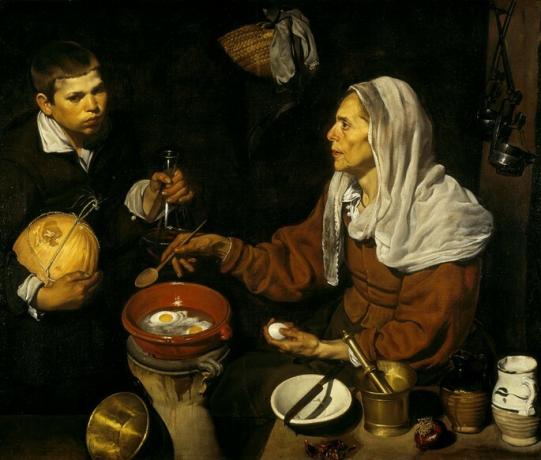
The Triumph of Bacchus or The Drunkards

Joseph's tunic

The coronation of the Virgin

Venus in the mirror
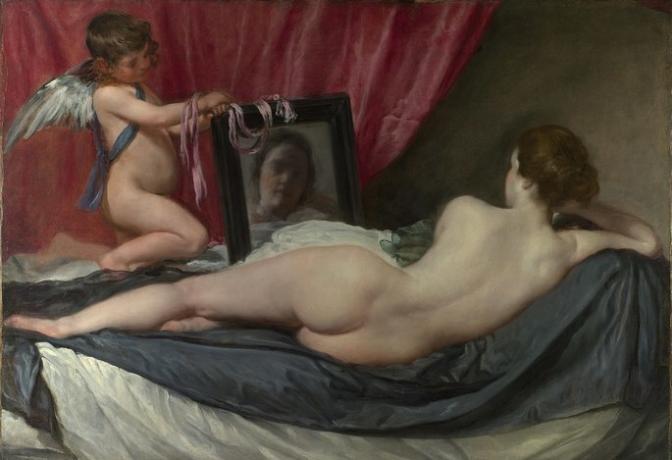
Portrait of the Infanta Margarita Teresa in a blue dress

The Surrender of Breda or The Spears

The fable of Arachne or The spinners



